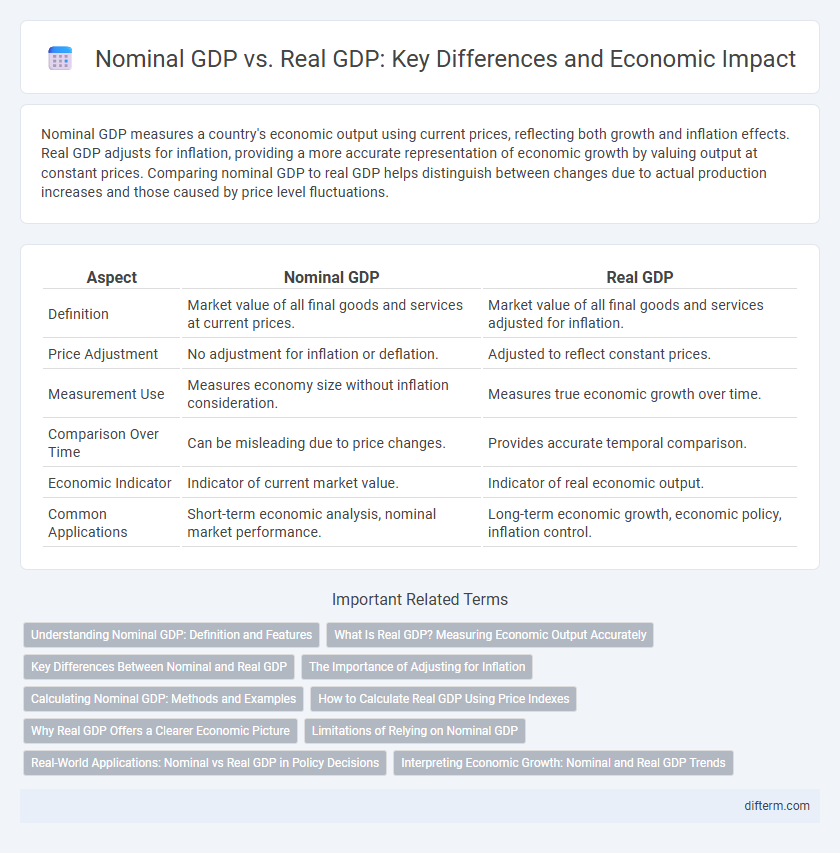Nominal GDP measures a country's economic output using current prices, reflecting both growth and inflation effects. Real GDP adjusts for inflation, providing a more accurate representation of economic growth by valuing output at constant prices. Comparing nominal GDP to real GDP helps distinguish between changes due to actual production increases and those caused by price level fluctuations.
Table of Comparison
| Aspect | Nominal GDP | Real GDP |
|---|---|---|
| Definition | Market value of all final goods and services at current prices. | Market value of all final goods and services adjusted for inflation. |
| Price Adjustment | No adjustment for inflation or deflation. | Adjusted to reflect constant prices. |
| Measurement Use | Measures economy size without inflation consideration. | Measures true economic growth over time. |
| Comparison Over Time | Can be misleading due to price changes. | Provides accurate temporal comparison. |
| Economic Indicator | Indicator of current market value. | Indicator of real economic output. |
| Common Applications | Short-term economic analysis, nominal market performance. | Long-term economic growth, economic policy, inflation control. |
Understanding Nominal GDP: Definition and Features
Nominal GDP measures the total market value of all final goods and services produced within a country's borders during a specific time period using current prices, without adjusting for inflation. It reflects the economy's size based on prevailing market prices, making it useful for comparing the economic output in monetary terms within that time frame. Key features of Nominal GDP include its sensitivity to price changes and its ability to capture both production volume and price level variations in an economy.
What Is Real GDP? Measuring Economic Output Accurately
Real GDP measures a country's economic output adjusted for inflation, reflecting the true value of goods and services produced. By using constant prices from a base year, Real GDP eliminates distortions caused by price changes over time. This adjustment enables more accurate comparisons of economic performance across different periods, providing a clearer picture of economic growth.
Key Differences Between Nominal and Real GDP
Nominal GDP measures a country's economic output using current prices, reflecting both inflation and growth, while Real GDP adjusts for inflation to show true economic growth over time. The key difference lies in inflation adjustment: Nominal GDP can overstate growth during periods of rising prices, whereas Real GDP provides a more accurate comparison across different years. Policymakers and economists rely on Real GDP to assess economic performance without distortions caused by price changes.
The Importance of Adjusting for Inflation
Nominal GDP measures the total economic output using current prices without accounting for inflation, which can misrepresent true economic growth. Real GDP adjusts nominal figures by removing the effects of inflation, providing a more accurate reflection of a country's economic performance and purchasing power over time. This adjustment is crucial for policymakers and economists to make informed decisions and compare economic data across different periods.
Calculating Nominal GDP: Methods and Examples
Calculating nominal GDP involves summing the market value of all final goods and services produced within a country in a given period, using current prices without adjusting for inflation. Common methods include the expenditure approach, which aggregates consumption, investment, government spending, and net exports, as well as the income approach that totals wages, rents, interest, and profits. For example, if a country's total output of goods and services is valued at $1 trillion at current prices in 2023, that figure represents its nominal GDP for the year.
How to Calculate Real GDP Using Price Indexes
Real GDP is calculated by adjusting Nominal GDP for changes in price levels using a price index, such as the GDP deflator or Consumer Price Index (CPI). The formula is Real GDP = Nominal GDP / (Price Index / 100), which removes inflation effects to reflect the true economic output. Accurate calculation of Real GDP enables meaningful comparisons of economic performance over different time periods.
Why Real GDP Offers a Clearer Economic Picture
Real GDP adjusts nominal GDP by accounting for inflation, providing a more accurate reflection of an economy's true growth and purchasing power over time. While nominal GDP measures the total market value of goods and services at current prices, Real GDP uses constant prices from a base year to eliminate distortions caused by price changes. This adjustment helps policymakers and analysts compare economic performance across different periods without inflation skewing the results.
Limitations of Relying on Nominal GDP
Nominal GDP can be misleading as it does not account for inflation, causing overestimation of economic growth during periods of rising prices. It fails to reflect changes in purchasing power, leading to inaccurate comparisons across different time periods. Reliance on nominal GDP alone obscures the true economic health and productivity of a country.
Real-World Applications: Nominal vs Real GDP in Policy Decisions
Nominal GDP measures the total market value of goods and services produced using current prices, while Real GDP adjusts for inflation, reflecting the true economic growth. Policymakers rely on Real GDP to formulate monetary and fiscal policies, as it provides a clearer picture of economic performance and purchasing power. Accurate assessment of Real GDP aids in setting interest rates, taxation levels, and government spending to stabilize the economy and promote sustainable growth.
Interpreting Economic Growth: Nominal and Real GDP Trends
Nominal GDP measures a country's economic output using current prices, reflecting both price changes and production volume, while Real GDP adjusts for inflation, providing a clearer picture of true economic growth by holding prices constant. Interpreting economic growth involves analyzing Real GDP trends to understand increases in production and overall economic health, as nominal figures may be distorted by inflation or deflation. Tracking both metrics is essential for policymakers and economists to differentiate between genuine growth and price level fluctuations within an economy.
Nominal GDP vs Real GDP Infographic

 difterm.com
difterm.com